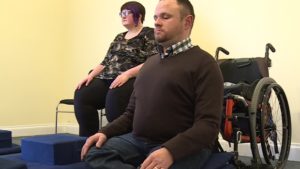Improve the Mental and Physical Health of Breast Cancer Survivors with Yoga
By John M. de Castro, Ph.D.
“It was very frightening. You wonder, obviously—Am I going to live through this? I’m convinced that yoga made all the difference in my treatment. The breathing was the thing that always came back for me—keeping the fear and panic down. I was in a PET scan machine for an hour. You just lie there and think terrible thoughts. I found my breathing. That was the most valuable thing.” – Debra Campagna
About 12.5% of women in the U.S. develop invasive breast cancer over their lifetimes and every year about 40,000 women die. Indeed, more women in the U.S. die from breast cancer than from any other cancer, besides lung cancer. Breast cancer diagnosis, however, is not always a death sentence. Death rates have been decreasing for decades from improved detection and treatment of breast cancer. Five-year survival rates are now at around 95%. The improved survival rates mean that more women are now living with cancer.
Surviving cancer, however, carries with it a number of problems. “Physical, emotional, and financial hardships often persist for years after diagnosis and treatment. Cancer survivors are also at greater risk for developing second cancers and other health conditions.” (National Cancer Survivors Day). Also, breast cancer survivors can have to deal with a heightened fear of reoccurrence. This is particularly true with metastatic cancer. Additionally, cancer survivors frequently suffer from anxiety, depression, mood disturbance, Post-Traumatic Stress Disorder (PTSD), sleep disturbance, fatigue, sexual dysfunction, loss of personal control, impaired quality of life, an alteration of their body image, and psychiatric symptoms which have been found to persist even ten years after remission. So, safe and effective treatments for the symptoms in breast cancer and the physical and psychological effects of the treatments are needed.
Mindfulness training has been shown to help with general cancer recovery and breast cancer recovery. Mindfulness helps to alleviate many of the residual physical and psychological symptoms, including stress, sleep disturbance, and anxiety and depression. Yoga practice has also been shown to be helpful with the residual symptoms and the psychological and physical ability to deal with cancer treatment. So, it’s reasonable to further explore the potential benefits of yoga practice for women during and after treatment.
In today’s Research News article “Effect of Long-term Yoga Practice on Psychological outcomes in Breast Cancer Survivors.” See summary below or view the full text of the study at: https://www.ncbi.nlm.nih.gov/pmc/articles/PMC5545946/, Amritanshu and colleagues recruited breast cancer survivors who were at least 6 months since the completion of treatment. They separated them into groups based upon whether they practiced yoga or not during the last year. The participants were measured for perceived stress, anxiety, depression, sleep quality, general health, and quality of life, including physical, psychological, social, and functional dimensions.
They found that the group that practiced yoga had significantly better psychological and physical health, sleep, and quality of life on all measures compared to the group that did not practice yoga. Hence, the overall health and well-being of the breast cancer survivors were significantly superior when they practiced yoga.
It should be kept in mind that this was not a manipulative study, so causation cannot be determined. It is possible that only those breast cancer survivors who were generally healthy would choose to participate in yoga. Previous research, however, that actively trained breast cancer patients in yoga has demonstrated that yoga practice produced significant improvements in the health and well-being of the participants. So, there is reason to believe that yoga practice was responsible for the present findings and that yoga practice improves the mental and physical health of breast cancer survivors.
So, improve the mental and physical health of breast cancer survivors with yoga.
“Studies suggest that doing yoga while going through breast cancer treatment helps you get through it with fewer side effects. Often doctors have to stop chemo or lower doses to levels that may not be as effective because people don’t tolerate the side effects. But yoga appears to decrease all kinds of side effects.” – Timothy McCall
CMCS – Center for Mindfulness and Contemplative Studies
This and other Contemplative Studies posts are also available on Google+ https://plus.google.com/106784388191201299496/posts and on Twitter @MindfulResearch
Study Summary
Amritanshu, R. R., Rao, R. M., Nagaratna, R., Veldore, V. H., Usha Rani, M. U., Gopinath, K. S., & Ajaikumar, B. S. (2017). Effect of Long-term Yoga Practice on Psychological outcomes in Breast Cancer Survivors. Indian Journal of Palliative Care, 23(3), 231–236. http://doi.org/10.4103/IJPC.IJPC_93_17
Abstract
Aim:
Breast cancer has become a pandemic with an ever-increasing incidence. Although better diagnostics and treatment modalities have reduced mortality, a large number of survivors face cancer and treatment-related long-term symptoms. Many survivors are taking up yoga for improving the quality of life (QoL). The present study attempts to evaluate predictors of psychological states in breast cancer survivors with long-term yoga experience.
Materials and Methods:
A case–control study recruited early breast cancer survivors, 30–65 years, completing treatment > 6 months before recruitment, and grouped them based on prior yoga experience (BCY, n = 27) or naïve (BCN, n = 25). Demography, cancer history, diet, exercise habits, and yoga schedule were collected and tools to assess stress, anxiety, depression, general health, and QoL were administered. Multivariate linear regression was done to identify predictors of psychological variables.
Results:
BCY had significantly lower stress, anxiety, depression, better general health, and QoL (P < 0.001). Global QoL and trait anxiety were significantly predicted by Yoga practice; depression was predicted by yoga practice, annual income, and sleep quality; state anxiety was predicted by Yoga practice and income; and stress was predicted by Yoga practice and sleep quality.
Conclusion:
Results indicate that breast cancer survivors, doing yoga, have better psychological profiles and are able to deal with demanding situations better. The psycho-oncogenic model of cancer etiology suggests that a better psychological state in survival has the potential to improve prognosis and survival outcomes and Yoga may be a suitable practice for staying cancer-free for a longer time.









